Manage Finances Assessment Task 1 - Crown Institute of Business and Technology
VerifiedAdded on 2023/06/10
|13
|4104
|390
AI Summary
This assessment task covers topics such as conservatism, financial statements, budgeting, due diligence, internal financial controls and more. Learn about the relationship between Australian Accounting Standards and accounting principles, the value of performing breakeven analysis, and the organizational planning and financial cycle.
Contribute Materials
Your contribution can guide someone’s learning journey. Share your
documents today.
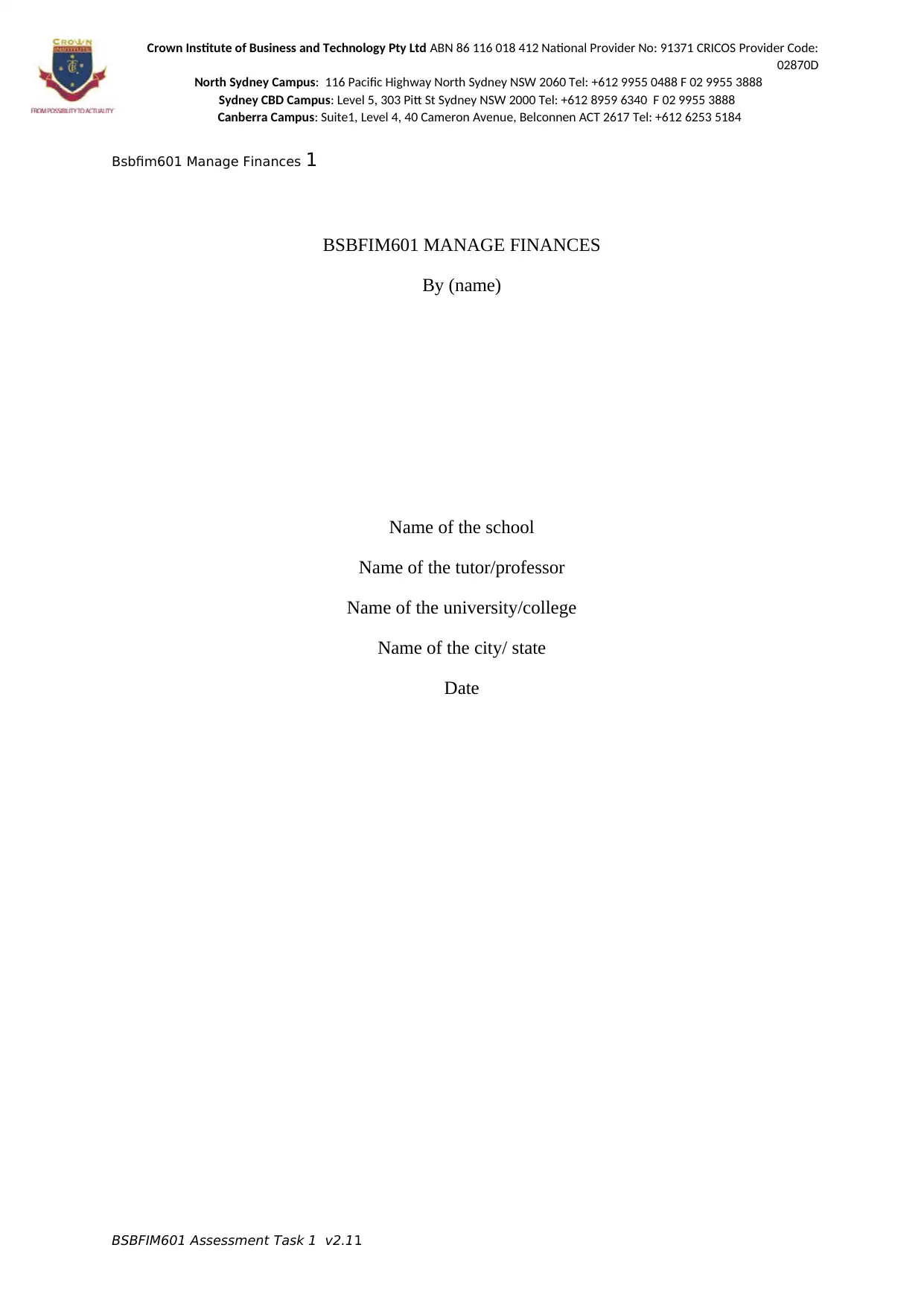
Crown Institute of Business and Technology Pty Ltd ABN 86 116 018 412 National Provider No: 91371 CRICOS Provider Code:
02870D
North Sydney Campus: 116 Pacific Highway North Sydney NSW 2060 Tel: +612 9955 0488 F 02 9955 3888
Sydney CBD Campus: Level 5, 303 Pitt St Sydney NSW 2000 Tel: +612 8959 6340 F 02 9955 3888
Canberra Campus: Suite1, Level 4, 40 Cameron Avenue, Belconnen ACT 2617 Tel: +612 6253 5184
Bsbfim601 Manage Finances 1
BSBFIM601 MANAGE FINANCES
By (name)
Name of the school
Name of the tutor/professor
Name of the university/college
Name of the city/ state
Date
BSBFIM601 Assessment Task 1 v2.11
02870D
North Sydney Campus: 116 Pacific Highway North Sydney NSW 2060 Tel: +612 9955 0488 F 02 9955 3888
Sydney CBD Campus: Level 5, 303 Pitt St Sydney NSW 2000 Tel: +612 8959 6340 F 02 9955 3888
Canberra Campus: Suite1, Level 4, 40 Cameron Avenue, Belconnen ACT 2617 Tel: +612 6253 5184
Bsbfim601 Manage Finances 1
BSBFIM601 MANAGE FINANCES
By (name)
Name of the school
Name of the tutor/professor
Name of the university/college
Name of the city/ state
Date
BSBFIM601 Assessment Task 1 v2.11
Secure Best Marks with AI Grader
Need help grading? Try our AI Grader for instant feedback on your assignments.
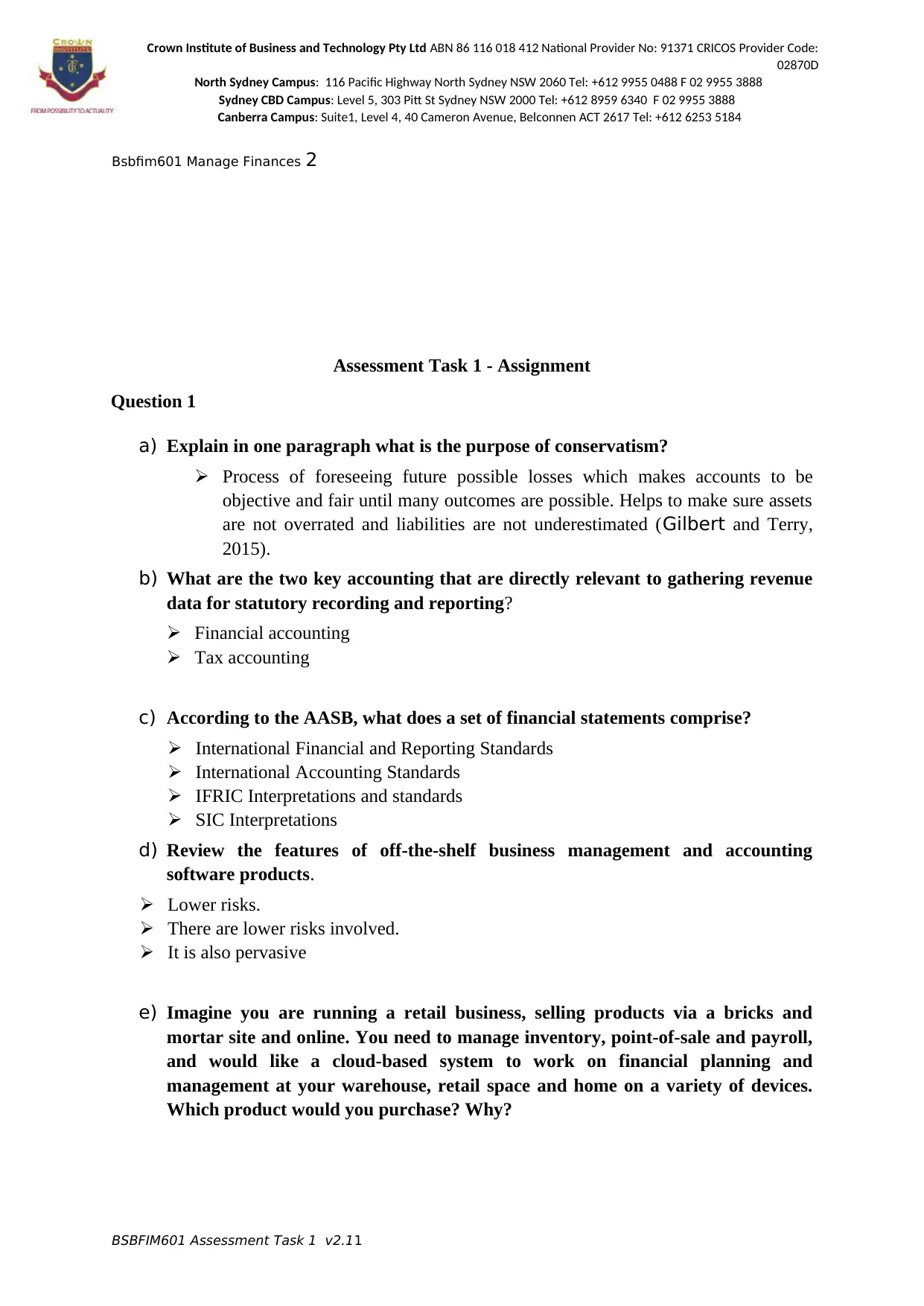
Crown Institute of Business and Technology Pty Ltd ABN 86 116 018 412 National Provider No: 91371 CRICOS Provider Code:
02870D
North Sydney Campus: 116 Pacific Highway North Sydney NSW 2060 Tel: +612 9955 0488 F 02 9955 3888
Sydney CBD Campus: Level 5, 303 Pitt St Sydney NSW 2000 Tel: +612 8959 6340 F 02 9955 3888
Canberra Campus: Suite1, Level 4, 40 Cameron Avenue, Belconnen ACT 2617 Tel: +612 6253 5184
Bsbfim601 Manage Finances 2
Assessment Task 1 - Assignment
Question 1
a) Explain in one paragraph what is the purpose of conservatism?
Process of foreseeing future possible losses which makes accounts to be
objective and fair until many outcomes are possible. Helps to make sure assets
are not overrated and liabilities are not underestimated (Gilbert and Terry,
2015).
b) What are the two key accounting that are directly relevant to gathering revenue
data for statutory recording and reporting?
Financial accounting
Tax accounting
c) According to the AASB, what does a set of financial statements comprise?
International Financial and Reporting Standards
International Accounting Standards
IFRIC Interpretations and standards
SIC Interpretations
d) Review the features of off-the-shelf business management and accounting
software products.
Lower risks.
There are lower risks involved.
It is also pervasive
e) Imagine you are running a retail business, selling products via a bricks and
mortar site and online. You need to manage inventory, point-of-sale and payroll,
and would like a cloud-based system to work on financial planning and
management at your warehouse, retail space and home on a variety of devices.
Which product would you purchase? Why?
BSBFIM601 Assessment Task 1 v2.11
02870D
North Sydney Campus: 116 Pacific Highway North Sydney NSW 2060 Tel: +612 9955 0488 F 02 9955 3888
Sydney CBD Campus: Level 5, 303 Pitt St Sydney NSW 2000 Tel: +612 8959 6340 F 02 9955 3888
Canberra Campus: Suite1, Level 4, 40 Cameron Avenue, Belconnen ACT 2617 Tel: +612 6253 5184
Bsbfim601 Manage Finances 2
Assessment Task 1 - Assignment
Question 1
a) Explain in one paragraph what is the purpose of conservatism?
Process of foreseeing future possible losses which makes accounts to be
objective and fair until many outcomes are possible. Helps to make sure assets
are not overrated and liabilities are not underestimated (Gilbert and Terry,
2015).
b) What are the two key accounting that are directly relevant to gathering revenue
data for statutory recording and reporting?
Financial accounting
Tax accounting
c) According to the AASB, what does a set of financial statements comprise?
International Financial and Reporting Standards
International Accounting Standards
IFRIC Interpretations and standards
SIC Interpretations
d) Review the features of off-the-shelf business management and accounting
software products.
Lower risks.
There are lower risks involved.
It is also pervasive
e) Imagine you are running a retail business, selling products via a bricks and
mortar site and online. You need to manage inventory, point-of-sale and payroll,
and would like a cloud-based system to work on financial planning and
management at your warehouse, retail space and home on a variety of devices.
Which product would you purchase? Why?
BSBFIM601 Assessment Task 1 v2.11
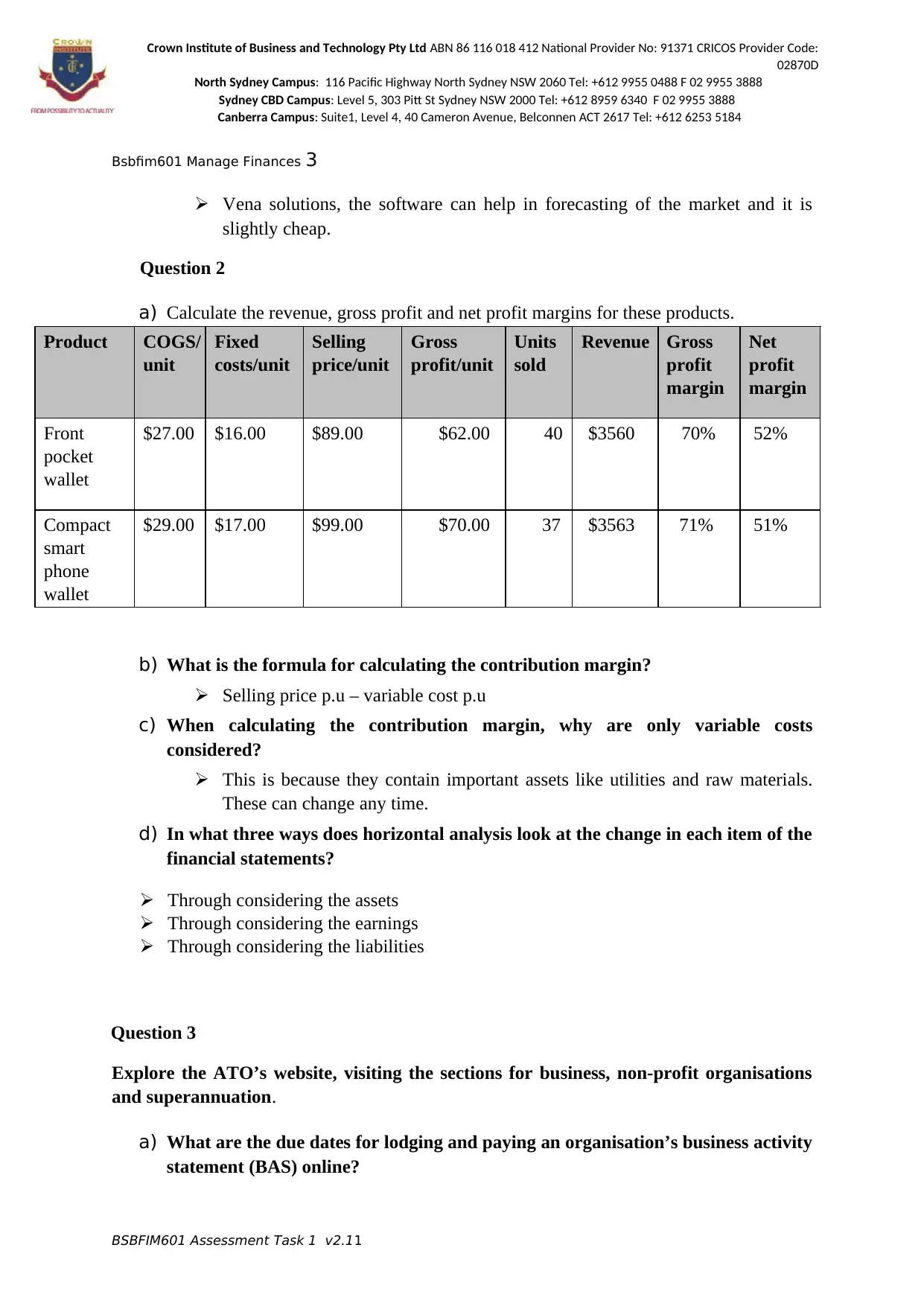
Crown Institute of Business and Technology Pty Ltd ABN 86 116 018 412 National Provider No: 91371 CRICOS Provider Code:
02870D
North Sydney Campus: 116 Pacific Highway North Sydney NSW 2060 Tel: +612 9955 0488 F 02 9955 3888
Sydney CBD Campus: Level 5, 303 Pitt St Sydney NSW 2000 Tel: +612 8959 6340 F 02 9955 3888
Canberra Campus: Suite1, Level 4, 40 Cameron Avenue, Belconnen ACT 2617 Tel: +612 6253 5184
Bsbfim601 Manage Finances 3
Vena solutions, the software can help in forecasting of the market and it is
slightly cheap.
Question 2
a) Calculate the revenue, gross profit and net profit margins for these products.
Product COGS/
unit
Fixed
costs/unit
Selling
price/unit
Gross
profit/unit
Units
sold
Revenue Gross
profit
margin
Net
profit
margin
Front
pocket
wallet
$27.00 $16.00 $89.00 $62.00 40 $3560 70% 52%
Compact
smart
phone
wallet
$29.00 $17.00 $99.00 $70.00 37 $3563 71% 51%
b) What is the formula for calculating the contribution margin?
Selling price p.u – variable cost p.u
c) When calculating the contribution margin, why are only variable costs
considered?
This is because they contain important assets like utilities and raw materials.
These can change any time.
d) In what three ways does horizontal analysis look at the change in each item of the
financial statements?
Through considering the assets
Through considering the earnings
Through considering the liabilities
Question 3
Explore the ATO’s website, visiting the sections for business, non-profit organisations
and superannuation.
a) What are the due dates for lodging and paying an organisation’s business activity
statement (BAS) online?
BSBFIM601 Assessment Task 1 v2.11
02870D
North Sydney Campus: 116 Pacific Highway North Sydney NSW 2060 Tel: +612 9955 0488 F 02 9955 3888
Sydney CBD Campus: Level 5, 303 Pitt St Sydney NSW 2000 Tel: +612 8959 6340 F 02 9955 3888
Canberra Campus: Suite1, Level 4, 40 Cameron Avenue, Belconnen ACT 2617 Tel: +612 6253 5184
Bsbfim601 Manage Finances 3
Vena solutions, the software can help in forecasting of the market and it is
slightly cheap.
Question 2
a) Calculate the revenue, gross profit and net profit margins for these products.
Product COGS/
unit
Fixed
costs/unit
Selling
price/unit
Gross
profit/unit
Units
sold
Revenue Gross
profit
margin
Net
profit
margin
Front
wallet
$27.00 $16.00 $89.00 $62.00 40 $3560 70% 52%
Compact
smart
phone
wallet
$29.00 $17.00 $99.00 $70.00 37 $3563 71% 51%
b) What is the formula for calculating the contribution margin?
Selling price p.u – variable cost p.u
c) When calculating the contribution margin, why are only variable costs
considered?
This is because they contain important assets like utilities and raw materials.
These can change any time.
d) In what three ways does horizontal analysis look at the change in each item of the
financial statements?
Through considering the assets
Through considering the earnings
Through considering the liabilities
Question 3
Explore the ATO’s website, visiting the sections for business, non-profit organisations
and superannuation.
a) What are the due dates for lodging and paying an organisation’s business activity
statement (BAS) online?
BSBFIM601 Assessment Task 1 v2.11
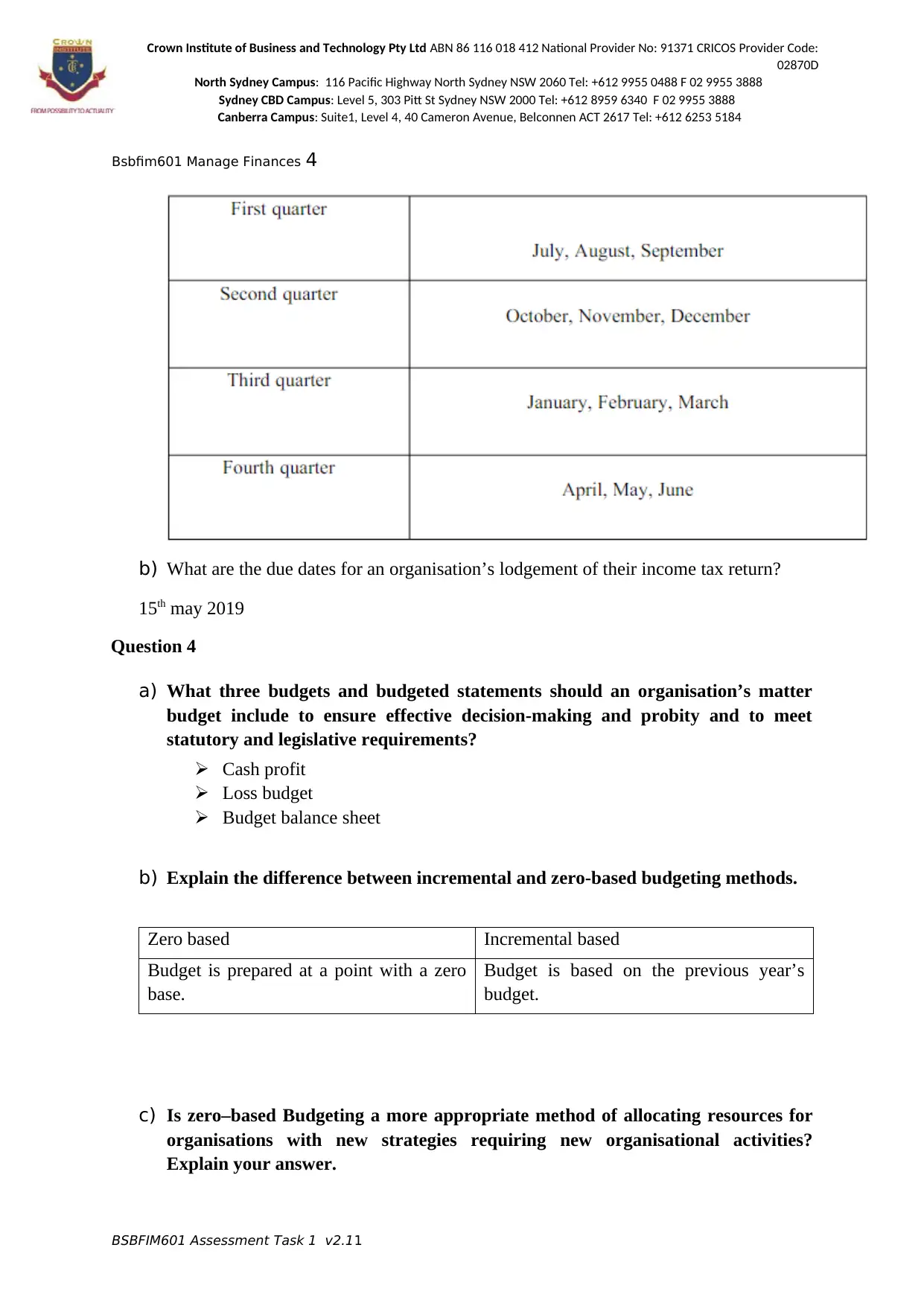
Crown Institute of Business and Technology Pty Ltd ABN 86 116 018 412 National Provider No: 91371 CRICOS Provider Code:
02870D
North Sydney Campus: 116 Pacific Highway North Sydney NSW 2060 Tel: +612 9955 0488 F 02 9955 3888
Sydney CBD Campus: Level 5, 303 Pitt St Sydney NSW 2000 Tel: +612 8959 6340 F 02 9955 3888
Canberra Campus: Suite1, Level 4, 40 Cameron Avenue, Belconnen ACT 2617 Tel: +612 6253 5184
Bsbfim601 Manage Finances 4
b) What are the due dates for an organisation’s lodgement of their income tax return?
15th may 2019
Question 4
a) What three budgets and budgeted statements should an organisation’s matter
budget include to ensure effective decision-making and probity and to meet
statutory and legislative requirements?
Cash profit
Loss budget
Budget balance sheet
b) Explain the difference between incremental and zero-based budgeting methods.
Zero based Incremental based
Budget is prepared at a point with a zero
base.
Budget is based on the previous year’s
budget.
c) Is zero–based Budgeting a more appropriate method of allocating resources for
organisations with new strategies requiring new organisational activities?
Explain your answer.
BSBFIM601 Assessment Task 1 v2.11
02870D
North Sydney Campus: 116 Pacific Highway North Sydney NSW 2060 Tel: +612 9955 0488 F 02 9955 3888
Sydney CBD Campus: Level 5, 303 Pitt St Sydney NSW 2000 Tel: +612 8959 6340 F 02 9955 3888
Canberra Campus: Suite1, Level 4, 40 Cameron Avenue, Belconnen ACT 2617 Tel: +612 6253 5184
Bsbfim601 Manage Finances 4
b) What are the due dates for an organisation’s lodgement of their income tax return?
15th may 2019
Question 4
a) What three budgets and budgeted statements should an organisation’s matter
budget include to ensure effective decision-making and probity and to meet
statutory and legislative requirements?
Cash profit
Loss budget
Budget balance sheet
b) Explain the difference between incremental and zero-based budgeting methods.
Zero based Incremental based
Budget is prepared at a point with a zero
base.
Budget is based on the previous year’s
budget.
c) Is zero–based Budgeting a more appropriate method of allocating resources for
organisations with new strategies requiring new organisational activities?
Explain your answer.
BSBFIM601 Assessment Task 1 v2.11
Secure Best Marks with AI Grader
Need help grading? Try our AI Grader for instant feedback on your assignments.
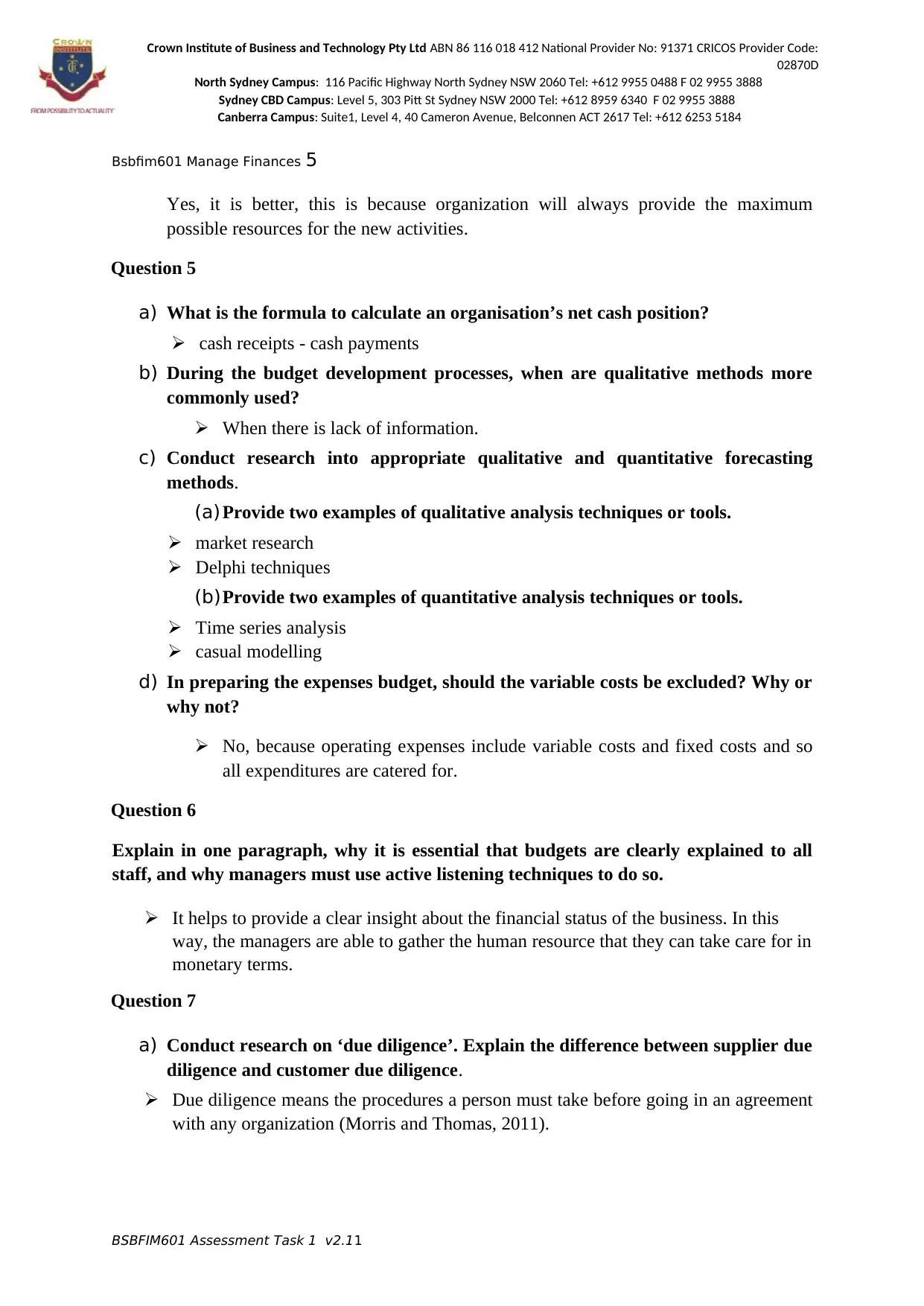
Crown Institute of Business and Technology Pty Ltd ABN 86 116 018 412 National Provider No: 91371 CRICOS Provider Code:
02870D
North Sydney Campus: 116 Pacific Highway North Sydney NSW 2060 Tel: +612 9955 0488 F 02 9955 3888
Sydney CBD Campus: Level 5, 303 Pitt St Sydney NSW 2000 Tel: +612 8959 6340 F 02 9955 3888
Canberra Campus: Suite1, Level 4, 40 Cameron Avenue, Belconnen ACT 2617 Tel: +612 6253 5184
Bsbfim601 Manage Finances 5
Yes, it is better, this is because organization will always provide the maximum
possible resources for the new activities.
Question 5
a) What is the formula to calculate an organisation’s net cash position?
cash receipts - cash payments
b) During the budget development processes, when are qualitative methods more
commonly used?
When there is lack of information.
c) Conduct research into appropriate qualitative and quantitative forecasting
methods.
(a) Provide two examples of qualitative analysis techniques or tools.
market research
Delphi techniques
(b)Provide two examples of quantitative analysis techniques or tools.
Time series analysis
casual modelling
d) In preparing the expenses budget, should the variable costs be excluded? Why or
why not?
No, because operating expenses include variable costs and fixed costs and so
all expenditures are catered for.
Question 6
Explain in one paragraph, why it is essential that budgets are clearly explained to all
staff, and why managers must use active listening techniques to do so.
It helps to provide a clear insight about the financial status of the business. In this
way, the managers are able to gather the human resource that they can take care for in
monetary terms.
Question 7
a) Conduct research on ‘due diligence’. Explain the difference between supplier due
diligence and customer due diligence.
Due diligence means the procedures a person must take before going in an agreement
with any organization (Morris and Thomas, 2011).
BSBFIM601 Assessment Task 1 v2.11
02870D
North Sydney Campus: 116 Pacific Highway North Sydney NSW 2060 Tel: +612 9955 0488 F 02 9955 3888
Sydney CBD Campus: Level 5, 303 Pitt St Sydney NSW 2000 Tel: +612 8959 6340 F 02 9955 3888
Canberra Campus: Suite1, Level 4, 40 Cameron Avenue, Belconnen ACT 2617 Tel: +612 6253 5184
Bsbfim601 Manage Finances 5
Yes, it is better, this is because organization will always provide the maximum
possible resources for the new activities.
Question 5
a) What is the formula to calculate an organisation’s net cash position?
cash receipts - cash payments
b) During the budget development processes, when are qualitative methods more
commonly used?
When there is lack of information.
c) Conduct research into appropriate qualitative and quantitative forecasting
methods.
(a) Provide two examples of qualitative analysis techniques or tools.
market research
Delphi techniques
(b)Provide two examples of quantitative analysis techniques or tools.
Time series analysis
casual modelling
d) In preparing the expenses budget, should the variable costs be excluded? Why or
why not?
No, because operating expenses include variable costs and fixed costs and so
all expenditures are catered for.
Question 6
Explain in one paragraph, why it is essential that budgets are clearly explained to all
staff, and why managers must use active listening techniques to do so.
It helps to provide a clear insight about the financial status of the business. In this
way, the managers are able to gather the human resource that they can take care for in
monetary terms.
Question 7
a) Conduct research on ‘due diligence’. Explain the difference between supplier due
diligence and customer due diligence.
Due diligence means the procedures a person must take before going in an agreement
with any organization (Morris and Thomas, 2011).
BSBFIM601 Assessment Task 1 v2.11
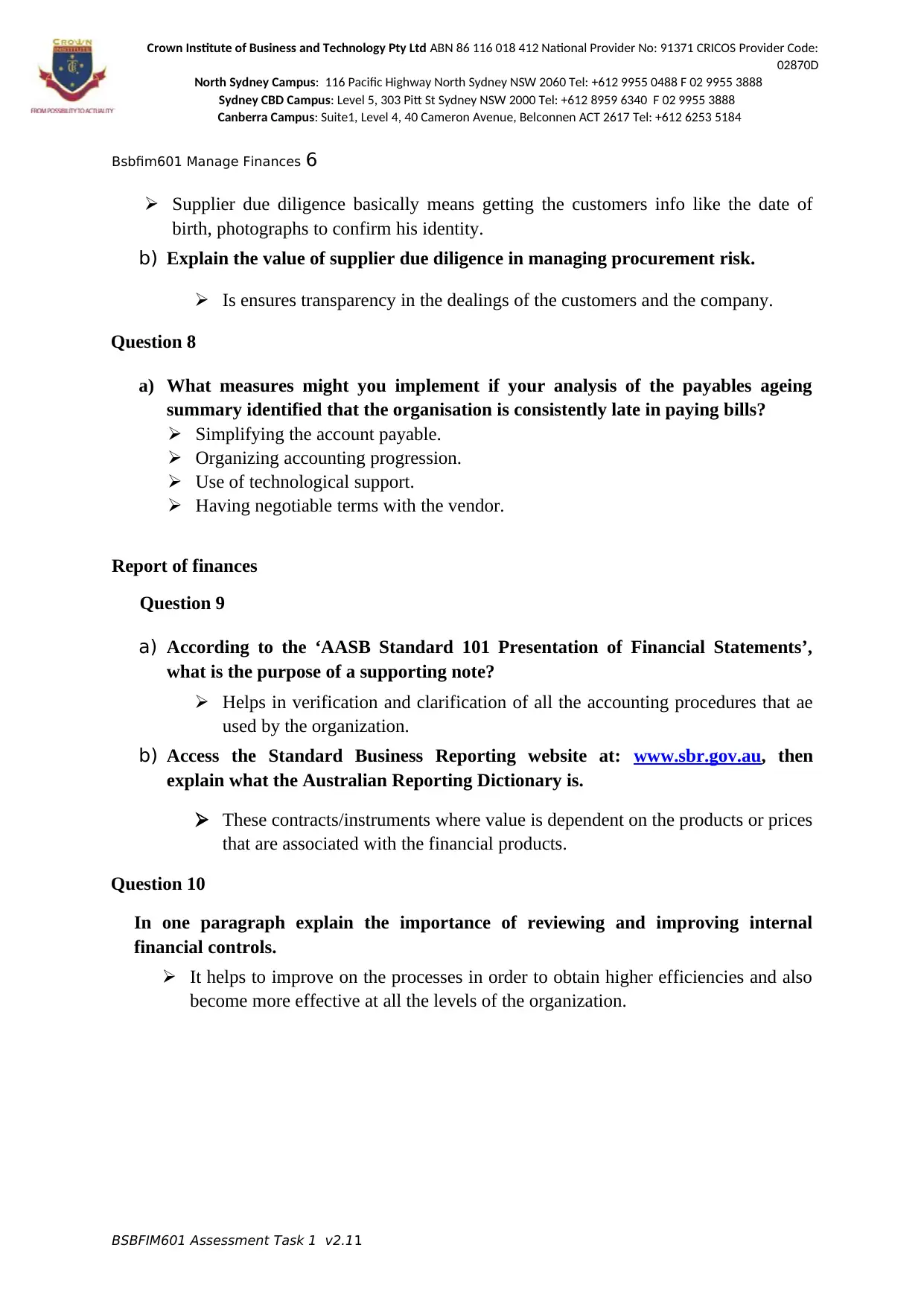
Crown Institute of Business and Technology Pty Ltd ABN 86 116 018 412 National Provider No: 91371 CRICOS Provider Code:
02870D
North Sydney Campus: 116 Pacific Highway North Sydney NSW 2060 Tel: +612 9955 0488 F 02 9955 3888
Sydney CBD Campus: Level 5, 303 Pitt St Sydney NSW 2000 Tel: +612 8959 6340 F 02 9955 3888
Canberra Campus: Suite1, Level 4, 40 Cameron Avenue, Belconnen ACT 2617 Tel: +612 6253 5184
Bsbfim601 Manage Finances 6
Supplier due diligence basically means getting the customers info like the date of
birth, photographs to confirm his identity.
b) Explain the value of supplier due diligence in managing procurement risk.
Is ensures transparency in the dealings of the customers and the company.
Question 8
a) What measures might you implement if your analysis of the payables ageing
summary identified that the organisation is consistently late in paying bills?
Simplifying the account payable.
Organizing accounting progression.
Use of technological support.
Having negotiable terms with the vendor.
Report of finances
Question 9
a) According to the ‘AASB Standard 101 Presentation of Financial Statements’,
what is the purpose of a supporting note?
Helps in verification and clarification of all the accounting procedures that ae
used by the organization.
b) Access the Standard Business Reporting website at: www.sbr.gov.au, then
explain what the Australian Reporting Dictionary is.
These contracts/instruments where value is dependent on the products or prices
that are associated with the financial products.
Question 10
In one paragraph explain the importance of reviewing and improving internal
financial controls.
It helps to improve on the processes in order to obtain higher efficiencies and also
become more effective at all the levels of the organization.
BSBFIM601 Assessment Task 1 v2.11
02870D
North Sydney Campus: 116 Pacific Highway North Sydney NSW 2060 Tel: +612 9955 0488 F 02 9955 3888
Sydney CBD Campus: Level 5, 303 Pitt St Sydney NSW 2000 Tel: +612 8959 6340 F 02 9955 3888
Canberra Campus: Suite1, Level 4, 40 Cameron Avenue, Belconnen ACT 2617 Tel: +612 6253 5184
Bsbfim601 Manage Finances 6
Supplier due diligence basically means getting the customers info like the date of
birth, photographs to confirm his identity.
b) Explain the value of supplier due diligence in managing procurement risk.
Is ensures transparency in the dealings of the customers and the company.
Question 8
a) What measures might you implement if your analysis of the payables ageing
summary identified that the organisation is consistently late in paying bills?
Simplifying the account payable.
Organizing accounting progression.
Use of technological support.
Having negotiable terms with the vendor.
Report of finances
Question 9
a) According to the ‘AASB Standard 101 Presentation of Financial Statements’,
what is the purpose of a supporting note?
Helps in verification and clarification of all the accounting procedures that ae
used by the organization.
b) Access the Standard Business Reporting website at: www.sbr.gov.au, then
explain what the Australian Reporting Dictionary is.
These contracts/instruments where value is dependent on the products or prices
that are associated with the financial products.
Question 10
In one paragraph explain the importance of reviewing and improving internal
financial controls.
It helps to improve on the processes in order to obtain higher efficiencies and also
become more effective at all the levels of the organization.
BSBFIM601 Assessment Task 1 v2.11
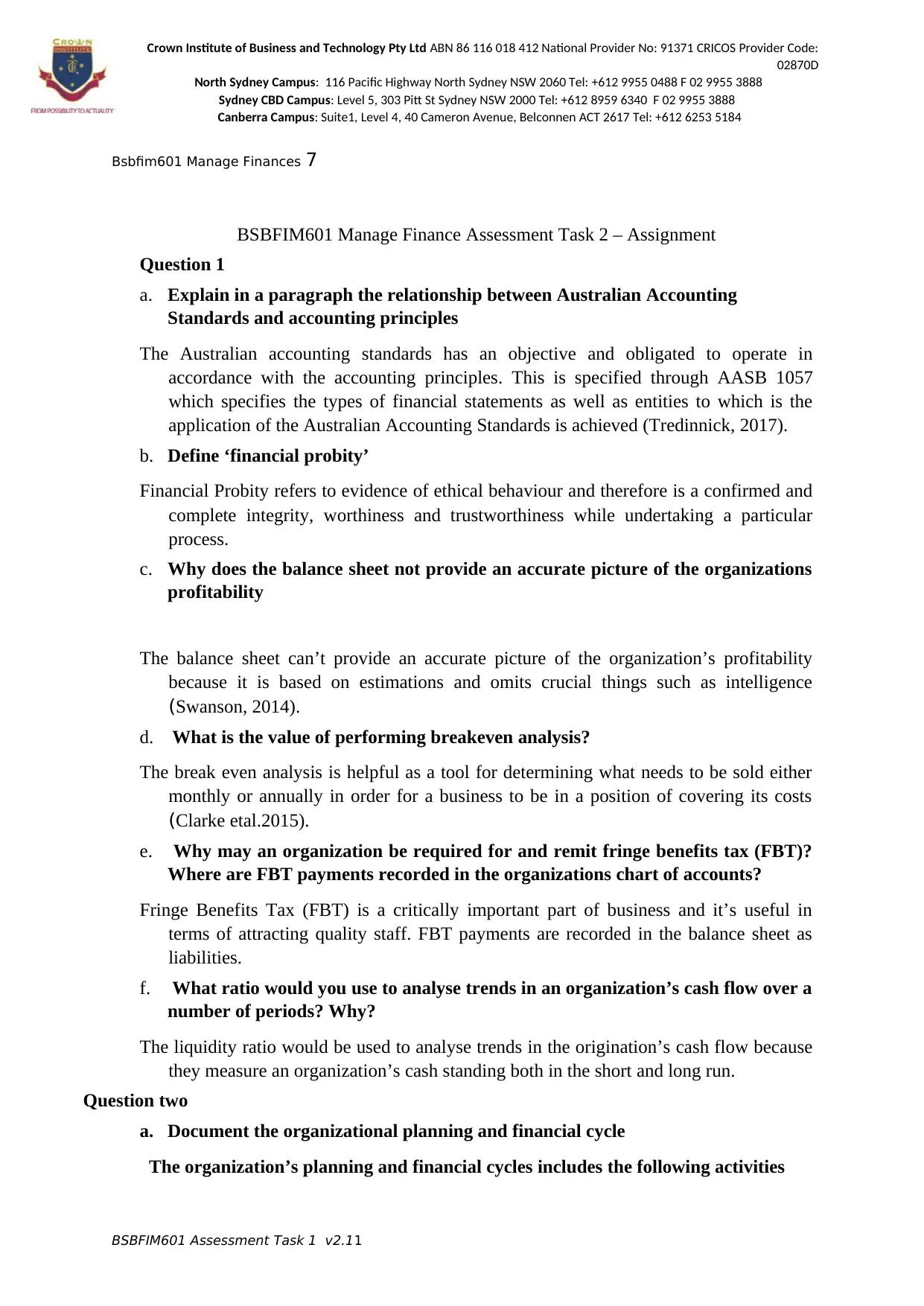
Crown Institute of Business and Technology Pty Ltd ABN 86 116 018 412 National Provider No: 91371 CRICOS Provider Code:
02870D
North Sydney Campus: 116 Pacific Highway North Sydney NSW 2060 Tel: +612 9955 0488 F 02 9955 3888
Sydney CBD Campus: Level 5, 303 Pitt St Sydney NSW 2000 Tel: +612 8959 6340 F 02 9955 3888
Canberra Campus: Suite1, Level 4, 40 Cameron Avenue, Belconnen ACT 2617 Tel: +612 6253 5184
Bsbfim601 Manage Finances 7
BSBFIM601 Manage Finance Assessment Task 2 – Assignment
Question 1
a. Explain in a paragraph the relationship between Australian Accounting
Standards and accounting principles
The Australian accounting standards has an objective and obligated to operate in
accordance with the accounting principles. This is specified through AASB 1057
which specifies the types of financial statements as well as entities to which is the
application of the Australian Accounting Standards is achieved (Tredinnick, 2017).
b. Define ‘financial probity’
Financial Probity refers to evidence of ethical behaviour and therefore is a confirmed and
complete integrity, worthiness and trustworthiness while undertaking a particular
process.
c. Why does the balance sheet not provide an accurate picture of the organizations
profitability
The balance sheet can’t provide an accurate picture of the organization’s profitability
because it is based on estimations and omits crucial things such as intelligence
(Swanson, 2014).
d. What is the value of performing breakeven analysis?
The break even analysis is helpful as a tool for determining what needs to be sold either
monthly or annually in order for a business to be in a position of covering its costs
(Clarke etal.2015).
e. Why may an organization be required for and remit fringe benefits tax (FBT)?
Where are FBT payments recorded in the organizations chart of accounts?
Fringe Benefits Tax (FBT) is a critically important part of business and it’s useful in
terms of attracting quality staff. FBT payments are recorded in the balance sheet as
liabilities.
f. What ratio would you use to analyse trends in an organization’s cash flow over a
number of periods? Why?
The liquidity ratio would be used to analyse trends in the origination’s cash flow because
they measure an organization’s cash standing both in the short and long run.
Question two
a. Document the organizational planning and financial cycle
The organization’s planning and financial cycles includes the following activities
BSBFIM601 Assessment Task 1 v2.11
02870D
North Sydney Campus: 116 Pacific Highway North Sydney NSW 2060 Tel: +612 9955 0488 F 02 9955 3888
Sydney CBD Campus: Level 5, 303 Pitt St Sydney NSW 2000 Tel: +612 8959 6340 F 02 9955 3888
Canberra Campus: Suite1, Level 4, 40 Cameron Avenue, Belconnen ACT 2617 Tel: +612 6253 5184
Bsbfim601 Manage Finances 7
BSBFIM601 Manage Finance Assessment Task 2 – Assignment
Question 1
a. Explain in a paragraph the relationship between Australian Accounting
Standards and accounting principles
The Australian accounting standards has an objective and obligated to operate in
accordance with the accounting principles. This is specified through AASB 1057
which specifies the types of financial statements as well as entities to which is the
application of the Australian Accounting Standards is achieved (Tredinnick, 2017).
b. Define ‘financial probity’
Financial Probity refers to evidence of ethical behaviour and therefore is a confirmed and
complete integrity, worthiness and trustworthiness while undertaking a particular
process.
c. Why does the balance sheet not provide an accurate picture of the organizations
profitability
The balance sheet can’t provide an accurate picture of the organization’s profitability
because it is based on estimations and omits crucial things such as intelligence
(Swanson, 2014).
d. What is the value of performing breakeven analysis?
The break even analysis is helpful as a tool for determining what needs to be sold either
monthly or annually in order for a business to be in a position of covering its costs
(Clarke etal.2015).
e. Why may an organization be required for and remit fringe benefits tax (FBT)?
Where are FBT payments recorded in the organizations chart of accounts?
Fringe Benefits Tax (FBT) is a critically important part of business and it’s useful in
terms of attracting quality staff. FBT payments are recorded in the balance sheet as
liabilities.
f. What ratio would you use to analyse trends in an organization’s cash flow over a
number of periods? Why?
The liquidity ratio would be used to analyse trends in the origination’s cash flow because
they measure an organization’s cash standing both in the short and long run.
Question two
a. Document the organizational planning and financial cycle
The organization’s planning and financial cycles includes the following activities
BSBFIM601 Assessment Task 1 v2.11
Paraphrase This Document
Need a fresh take? Get an instant paraphrase of this document with our AI Paraphraser
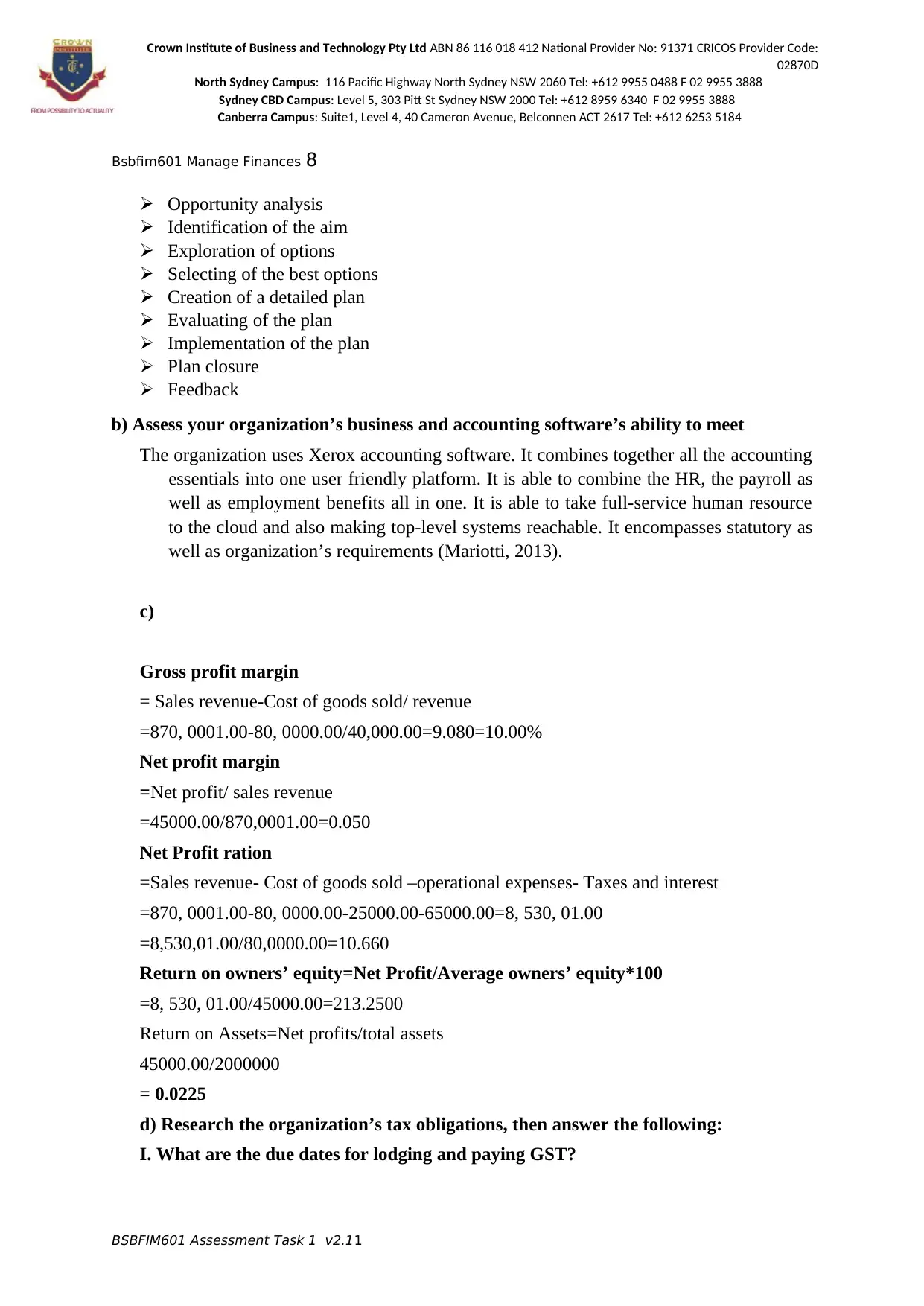
Crown Institute of Business and Technology Pty Ltd ABN 86 116 018 412 National Provider No: 91371 CRICOS Provider Code:
02870D
North Sydney Campus: 116 Pacific Highway North Sydney NSW 2060 Tel: +612 9955 0488 F 02 9955 3888
Sydney CBD Campus: Level 5, 303 Pitt St Sydney NSW 2000 Tel: +612 8959 6340 F 02 9955 3888
Canberra Campus: Suite1, Level 4, 40 Cameron Avenue, Belconnen ACT 2617 Tel: +612 6253 5184
Bsbfim601 Manage Finances 8
Opportunity analysis
Identification of the aim
Exploration of options
Selecting of the best options
Creation of a detailed plan
Evaluating of the plan
Implementation of the plan
Plan closure
Feedback
b) Assess your organization’s business and accounting software’s ability to meet
The organization uses Xerox accounting software. It combines together all the accounting
essentials into one user friendly platform. It is able to combine the HR, the payroll as
well as employment benefits all in one. It is able to take full-service human resource
to the cloud and also making top-level systems reachable. It encompasses statutory as
well as organization’s requirements (Mariotti, 2013).
c)
Gross profit margin
= Sales revenue-Cost of goods sold/ revenue
=870, 0001.00-80, 0000.00/40,000.00=9.080=10.00%
Net profit margin
=Net profit/ sales revenue
=45000.00/870,0001.00=0.050
Net Profit ration
=Sales revenue- Cost of goods sold –operational expenses- Taxes and interest
=870, 0001.00-80, 0000.00-25000.00-65000.00=8, 530, 01.00
=8,530,01.00/80,0000.00=10.660
Return on owners’ equity=Net Profit/Average owners’ equity*100
=8, 530, 01.00/45000.00=213.2500
Return on Assets=Net profits/total assets
45000.00/2000000
= 0.0225
d) Research the organization’s tax obligations, then answer the following:
I. What are the due dates for lodging and paying GST?
BSBFIM601 Assessment Task 1 v2.11
02870D
North Sydney Campus: 116 Pacific Highway North Sydney NSW 2060 Tel: +612 9955 0488 F 02 9955 3888
Sydney CBD Campus: Level 5, 303 Pitt St Sydney NSW 2000 Tel: +612 8959 6340 F 02 9955 3888
Canberra Campus: Suite1, Level 4, 40 Cameron Avenue, Belconnen ACT 2617 Tel: +612 6253 5184
Bsbfim601 Manage Finances 8
Opportunity analysis
Identification of the aim
Exploration of options
Selecting of the best options
Creation of a detailed plan
Evaluating of the plan
Implementation of the plan
Plan closure
Feedback
b) Assess your organization’s business and accounting software’s ability to meet
The organization uses Xerox accounting software. It combines together all the accounting
essentials into one user friendly platform. It is able to combine the HR, the payroll as
well as employment benefits all in one. It is able to take full-service human resource
to the cloud and also making top-level systems reachable. It encompasses statutory as
well as organization’s requirements (Mariotti, 2013).
c)
Gross profit margin
= Sales revenue-Cost of goods sold/ revenue
=870, 0001.00-80, 0000.00/40,000.00=9.080=10.00%
Net profit margin
=Net profit/ sales revenue
=45000.00/870,0001.00=0.050
Net Profit ration
=Sales revenue- Cost of goods sold –operational expenses- Taxes and interest
=870, 0001.00-80, 0000.00-25000.00-65000.00=8, 530, 01.00
=8,530,01.00/80,0000.00=10.660
Return on owners’ equity=Net Profit/Average owners’ equity*100
=8, 530, 01.00/45000.00=213.2500
Return on Assets=Net profits/total assets
45000.00/2000000
= 0.0225
d) Research the organization’s tax obligations, then answer the following:
I. What are the due dates for lodging and paying GST?
BSBFIM601 Assessment Task 1 v2.11
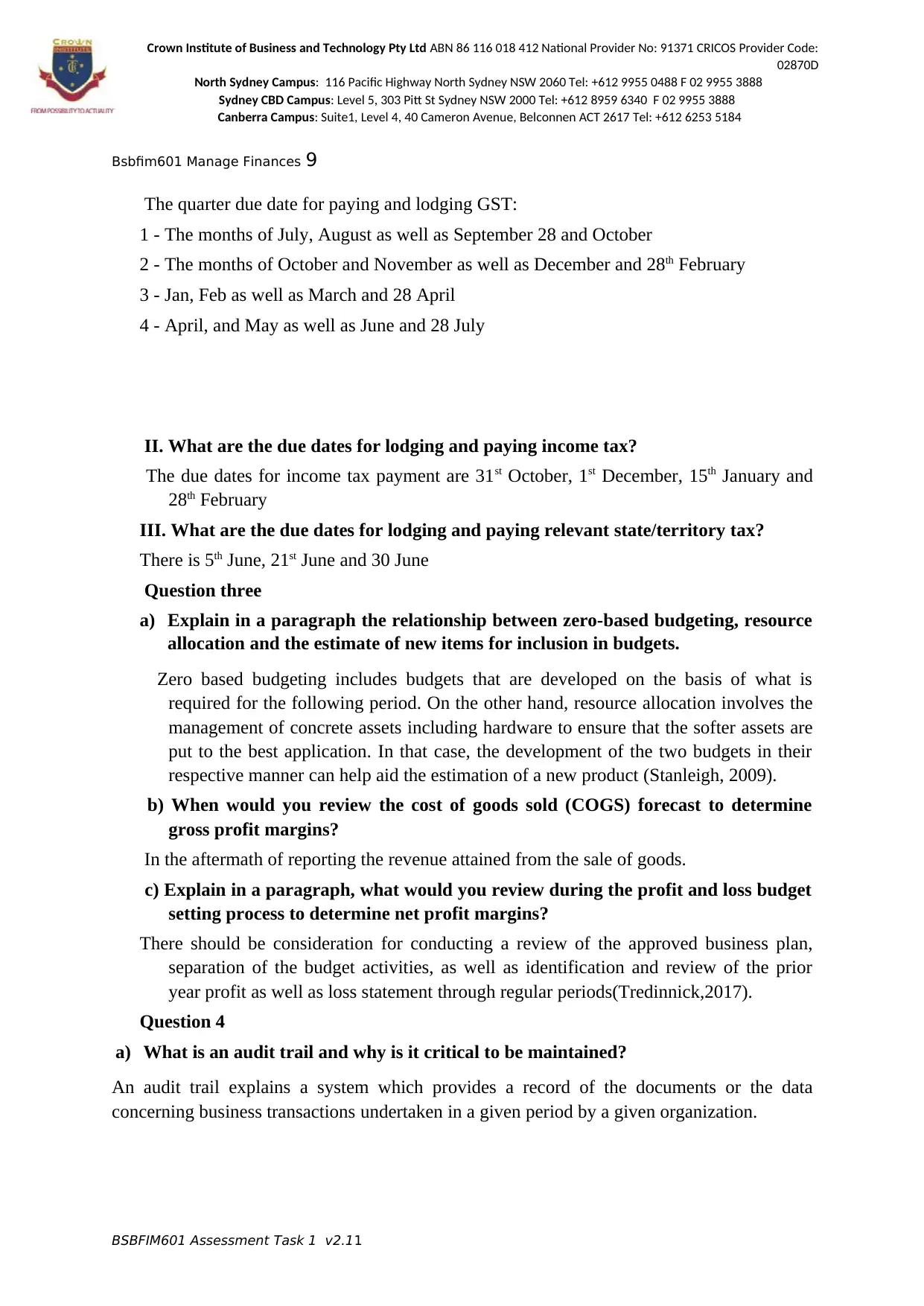
Crown Institute of Business and Technology Pty Ltd ABN 86 116 018 412 National Provider No: 91371 CRICOS Provider Code:
02870D
North Sydney Campus: 116 Pacific Highway North Sydney NSW 2060 Tel: +612 9955 0488 F 02 9955 3888
Sydney CBD Campus: Level 5, 303 Pitt St Sydney NSW 2000 Tel: +612 8959 6340 F 02 9955 3888
Canberra Campus: Suite1, Level 4, 40 Cameron Avenue, Belconnen ACT 2617 Tel: +612 6253 5184
Bsbfim601 Manage Finances 9
The quarter due date for paying and lodging GST:
1 - The months of July, August as well as September 28 and October
2 - The months of October and November as well as December and 28th February
3 - Jan, Feb as well as March and 28 April
4 - April, and May as well as June and 28 July
II. What are the due dates for lodging and paying income tax?
The due dates for income tax payment are 31st October, 1st December, 15th January and
28th February
III. What are the due dates for lodging and paying relevant state/territory tax?
There is 5th June, 21st June and 30 June
Question three
a) Explain in a paragraph the relationship between zero-based budgeting, resource
allocation and the estimate of new items for inclusion in budgets.
Zero based budgeting includes budgets that are developed on the basis of what is
required for the following period. On the other hand, resource allocation involves the
management of concrete assets including hardware to ensure that the softer assets are
put to the best application. In that case, the development of the two budgets in their
respective manner can help aid the estimation of a new product (Stanleigh, 2009).
b) When would you review the cost of goods sold (COGS) forecast to determine
gross profit margins?
In the aftermath of reporting the revenue attained from the sale of goods.
c) Explain in a paragraph, what would you review during the profit and loss budget
setting process to determine net profit margins?
There should be consideration for conducting a review of the approved business plan,
separation of the budget activities, as well as identification and review of the prior
year profit as well as loss statement through regular periods(Tredinnick,2017).
Question 4
a) What is an audit trail and why is it critical to be maintained?
An audit trail explains a system which provides a record of the documents or the data
concerning business transactions undertaken in a given period by a given organization.
BSBFIM601 Assessment Task 1 v2.11
02870D
North Sydney Campus: 116 Pacific Highway North Sydney NSW 2060 Tel: +612 9955 0488 F 02 9955 3888
Sydney CBD Campus: Level 5, 303 Pitt St Sydney NSW 2000 Tel: +612 8959 6340 F 02 9955 3888
Canberra Campus: Suite1, Level 4, 40 Cameron Avenue, Belconnen ACT 2617 Tel: +612 6253 5184
Bsbfim601 Manage Finances 9
The quarter due date for paying and lodging GST:
1 - The months of July, August as well as September 28 and October
2 - The months of October and November as well as December and 28th February
3 - Jan, Feb as well as March and 28 April
4 - April, and May as well as June and 28 July
II. What are the due dates for lodging and paying income tax?
The due dates for income tax payment are 31st October, 1st December, 15th January and
28th February
III. What are the due dates for lodging and paying relevant state/territory tax?
There is 5th June, 21st June and 30 June
Question three
a) Explain in a paragraph the relationship between zero-based budgeting, resource
allocation and the estimate of new items for inclusion in budgets.
Zero based budgeting includes budgets that are developed on the basis of what is
required for the following period. On the other hand, resource allocation involves the
management of concrete assets including hardware to ensure that the softer assets are
put to the best application. In that case, the development of the two budgets in their
respective manner can help aid the estimation of a new product (Stanleigh, 2009).
b) When would you review the cost of goods sold (COGS) forecast to determine
gross profit margins?
In the aftermath of reporting the revenue attained from the sale of goods.
c) Explain in a paragraph, what would you review during the profit and loss budget
setting process to determine net profit margins?
There should be consideration for conducting a review of the approved business plan,
separation of the budget activities, as well as identification and review of the prior
year profit as well as loss statement through regular periods(Tredinnick,2017).
Question 4
a) What is an audit trail and why is it critical to be maintained?
An audit trail explains a system which provides a record of the documents or the data
concerning business transactions undertaken in a given period by a given organization.
BSBFIM601 Assessment Task 1 v2.11
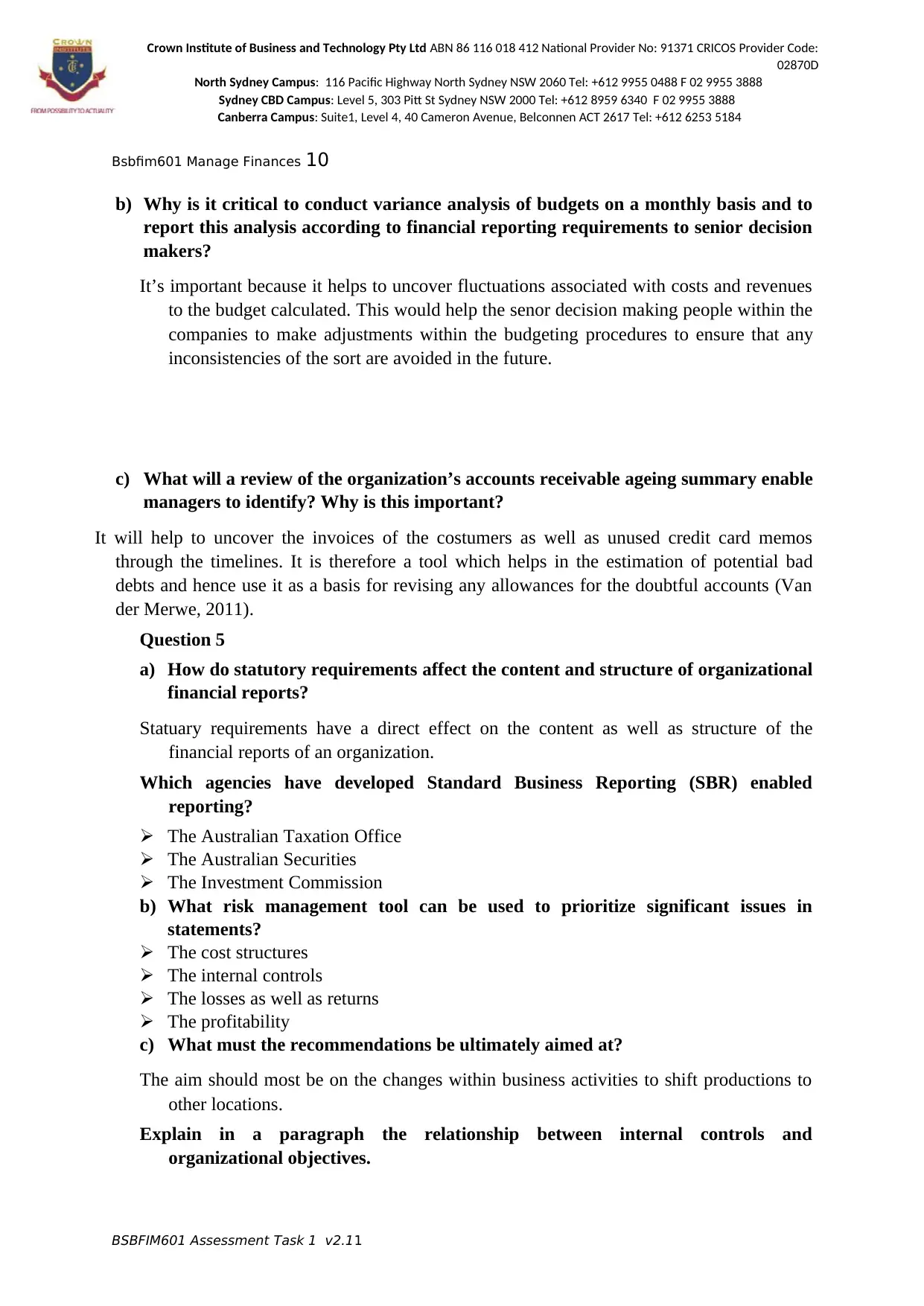
Crown Institute of Business and Technology Pty Ltd ABN 86 116 018 412 National Provider No: 91371 CRICOS Provider Code:
02870D
North Sydney Campus: 116 Pacific Highway North Sydney NSW 2060 Tel: +612 9955 0488 F 02 9955 3888
Sydney CBD Campus: Level 5, 303 Pitt St Sydney NSW 2000 Tel: +612 8959 6340 F 02 9955 3888
Canberra Campus: Suite1, Level 4, 40 Cameron Avenue, Belconnen ACT 2617 Tel: +612 6253 5184
Bsbfim601 Manage Finances 10
b) Why is it critical to conduct variance analysis of budgets on a monthly basis and to
report this analysis according to financial reporting requirements to senior decision
makers?
It’s important because it helps to uncover fluctuations associated with costs and revenues
to the budget calculated. This would help the senor decision making people within the
companies to make adjustments within the budgeting procedures to ensure that any
inconsistencies of the sort are avoided in the future.
c) What will a review of the organization’s accounts receivable ageing summary enable
managers to identify? Why is this important?
It will help to uncover the invoices of the costumers as well as unused credit card memos
through the timelines. It is therefore a tool which helps in the estimation of potential bad
debts and hence use it as a basis for revising any allowances for the doubtful accounts (Van
der Merwe, 2011).
Question 5
a) How do statutory requirements affect the content and structure of organizational
financial reports?
Statuary requirements have a direct effect on the content as well as structure of the
financial reports of an organization.
Which agencies have developed Standard Business Reporting (SBR) enabled
reporting?
The Australian Taxation Office
The Australian Securities
The Investment Commission
b) What risk management tool can be used to prioritize significant issues in
statements?
The cost structures
The internal controls
The losses as well as returns
The profitability
c) What must the recommendations be ultimately aimed at?
The aim should most be on the changes within business activities to shift productions to
other locations.
Explain in a paragraph the relationship between internal controls and
organizational objectives.
BSBFIM601 Assessment Task 1 v2.11
02870D
North Sydney Campus: 116 Pacific Highway North Sydney NSW 2060 Tel: +612 9955 0488 F 02 9955 3888
Sydney CBD Campus: Level 5, 303 Pitt St Sydney NSW 2000 Tel: +612 8959 6340 F 02 9955 3888
Canberra Campus: Suite1, Level 4, 40 Cameron Avenue, Belconnen ACT 2617 Tel: +612 6253 5184
Bsbfim601 Manage Finances 10
b) Why is it critical to conduct variance analysis of budgets on a monthly basis and to
report this analysis according to financial reporting requirements to senior decision
makers?
It’s important because it helps to uncover fluctuations associated with costs and revenues
to the budget calculated. This would help the senor decision making people within the
companies to make adjustments within the budgeting procedures to ensure that any
inconsistencies of the sort are avoided in the future.
c) What will a review of the organization’s accounts receivable ageing summary enable
managers to identify? Why is this important?
It will help to uncover the invoices of the costumers as well as unused credit card memos
through the timelines. It is therefore a tool which helps in the estimation of potential bad
debts and hence use it as a basis for revising any allowances for the doubtful accounts (Van
der Merwe, 2011).
Question 5
a) How do statutory requirements affect the content and structure of organizational
financial reports?
Statuary requirements have a direct effect on the content as well as structure of the
financial reports of an organization.
Which agencies have developed Standard Business Reporting (SBR) enabled
reporting?
The Australian Taxation Office
The Australian Securities
The Investment Commission
b) What risk management tool can be used to prioritize significant issues in
statements?
The cost structures
The internal controls
The losses as well as returns
The profitability
c) What must the recommendations be ultimately aimed at?
The aim should most be on the changes within business activities to shift productions to
other locations.
Explain in a paragraph the relationship between internal controls and
organizational objectives.
BSBFIM601 Assessment Task 1 v2.11
Secure Best Marks with AI Grader
Need help grading? Try our AI Grader for instant feedback on your assignments.
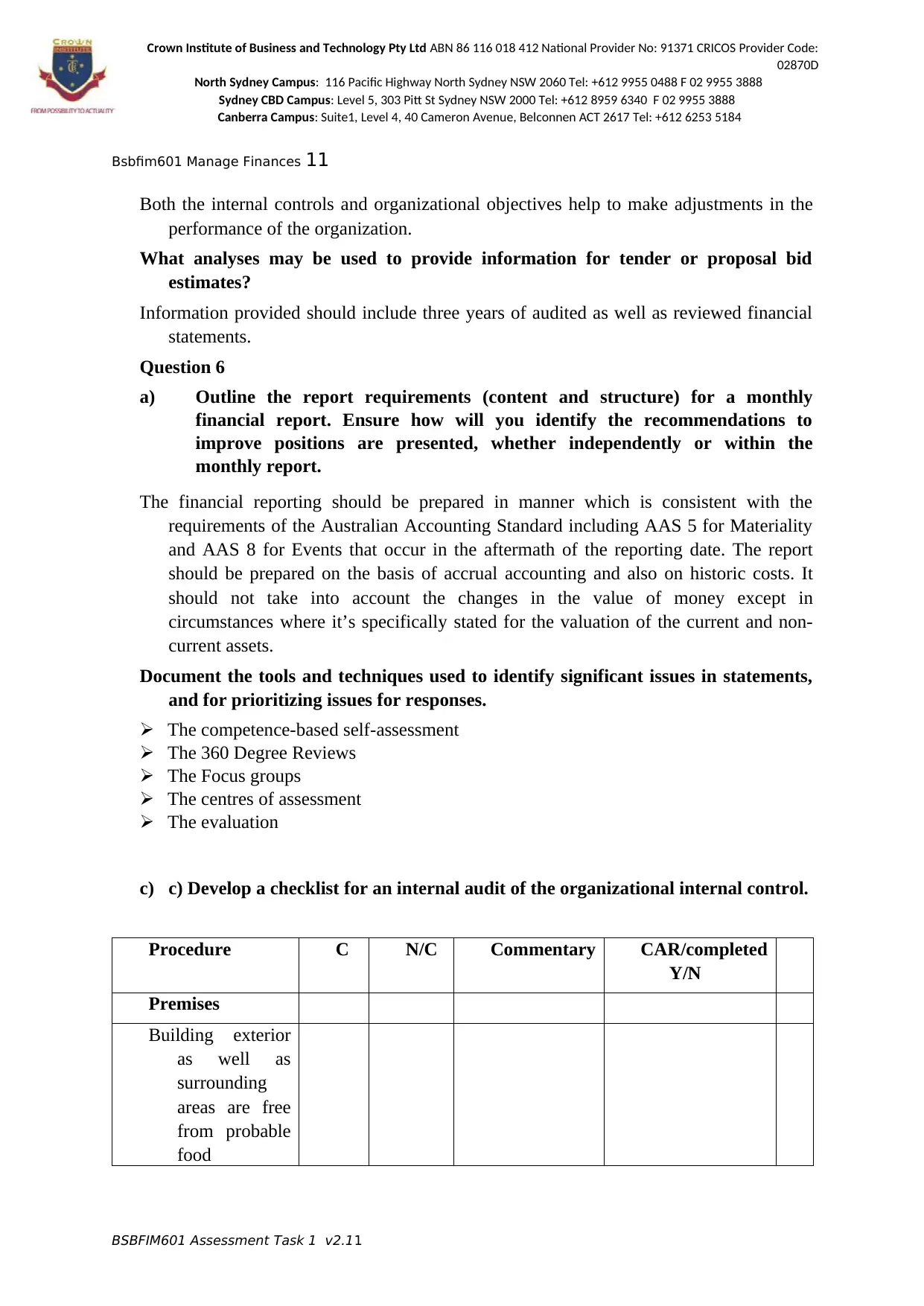
Crown Institute of Business and Technology Pty Ltd ABN 86 116 018 412 National Provider No: 91371 CRICOS Provider Code:
02870D
North Sydney Campus: 116 Pacific Highway North Sydney NSW 2060 Tel: +612 9955 0488 F 02 9955 3888
Sydney CBD Campus: Level 5, 303 Pitt St Sydney NSW 2000 Tel: +612 8959 6340 F 02 9955 3888
Canberra Campus: Suite1, Level 4, 40 Cameron Avenue, Belconnen ACT 2617 Tel: +612 6253 5184
Bsbfim601 Manage Finances 11
Both the internal controls and organizational objectives help to make adjustments in the
performance of the organization.
What analyses may be used to provide information for tender or proposal bid
estimates?
Information provided should include three years of audited as well as reviewed financial
statements.
Question 6
a) Outline the report requirements (content and structure) for a monthly
financial report. Ensure how will you identify the recommendations to
improve positions are presented, whether independently or within the
monthly report.
The financial reporting should be prepared in manner which is consistent with the
requirements of the Australian Accounting Standard including AAS 5 for Materiality
and AAS 8 for Events that occur in the aftermath of the reporting date. The report
should be prepared on the basis of accrual accounting and also on historic costs. It
should not take into account the changes in the value of money except in
circumstances where it’s specifically stated for the valuation of the current and non-
current assets.
Document the tools and techniques used to identify significant issues in statements,
and for prioritizing issues for responses.
The competence-based self-assessment
The 360 Degree Reviews
The Focus groups
The centres of assessment
The evaluation
c) c) Develop a checklist for an internal audit of the organizational internal control.
Procedure C N/C Commentary CAR/completed
Y/N
Premises
Building exterior
as well as
surrounding
areas are free
from probable
food
BSBFIM601 Assessment Task 1 v2.11
02870D
North Sydney Campus: 116 Pacific Highway North Sydney NSW 2060 Tel: +612 9955 0488 F 02 9955 3888
Sydney CBD Campus: Level 5, 303 Pitt St Sydney NSW 2000 Tel: +612 8959 6340 F 02 9955 3888
Canberra Campus: Suite1, Level 4, 40 Cameron Avenue, Belconnen ACT 2617 Tel: +612 6253 5184
Bsbfim601 Manage Finances 11
Both the internal controls and organizational objectives help to make adjustments in the
performance of the organization.
What analyses may be used to provide information for tender or proposal bid
estimates?
Information provided should include three years of audited as well as reviewed financial
statements.
Question 6
a) Outline the report requirements (content and structure) for a monthly
financial report. Ensure how will you identify the recommendations to
improve positions are presented, whether independently or within the
monthly report.
The financial reporting should be prepared in manner which is consistent with the
requirements of the Australian Accounting Standard including AAS 5 for Materiality
and AAS 8 for Events that occur in the aftermath of the reporting date. The report
should be prepared on the basis of accrual accounting and also on historic costs. It
should not take into account the changes in the value of money except in
circumstances where it’s specifically stated for the valuation of the current and non-
current assets.
Document the tools and techniques used to identify significant issues in statements,
and for prioritizing issues for responses.
The competence-based self-assessment
The 360 Degree Reviews
The Focus groups
The centres of assessment
The evaluation
c) c) Develop a checklist for an internal audit of the organizational internal control.
Procedure C N/C Commentary CAR/completed
Y/N
Premises
Building exterior
as well as
surrounding
areas are free
from probable
food
BSBFIM601 Assessment Task 1 v2.11
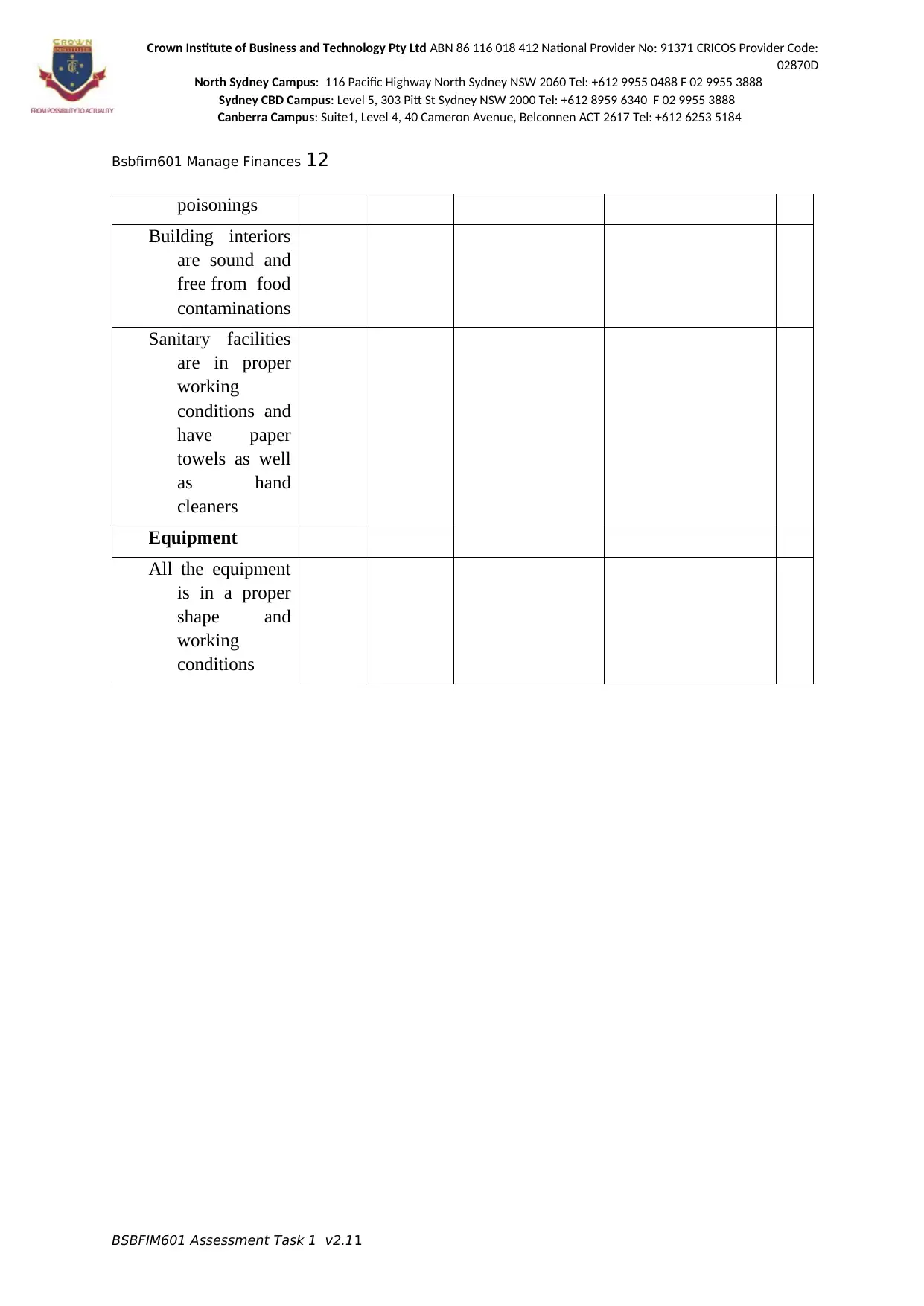
Crown Institute of Business and Technology Pty Ltd ABN 86 116 018 412 National Provider No: 91371 CRICOS Provider Code:
02870D
North Sydney Campus: 116 Pacific Highway North Sydney NSW 2060 Tel: +612 9955 0488 F 02 9955 3888
Sydney CBD Campus: Level 5, 303 Pitt St Sydney NSW 2000 Tel: +612 8959 6340 F 02 9955 3888
Canberra Campus: Suite1, Level 4, 40 Cameron Avenue, Belconnen ACT 2617 Tel: +612 6253 5184
Bsbfim601 Manage Finances 12
poisonings
Building interiors
are sound and
free from food
contaminations
Sanitary facilities
are in proper
working
conditions and
have paper
towels as well
as hand
cleaners
Equipment
All the equipment
is in a proper
shape and
working
conditions
BSBFIM601 Assessment Task 1 v2.11
02870D
North Sydney Campus: 116 Pacific Highway North Sydney NSW 2060 Tel: +612 9955 0488 F 02 9955 3888
Sydney CBD Campus: Level 5, 303 Pitt St Sydney NSW 2000 Tel: +612 8959 6340 F 02 9955 3888
Canberra Campus: Suite1, Level 4, 40 Cameron Avenue, Belconnen ACT 2617 Tel: +612 6253 5184
Bsbfim601 Manage Finances 12
poisonings
Building interiors
are sound and
free from food
contaminations
Sanitary facilities
are in proper
working
conditions and
have paper
towels as well
as hand
cleaners
Equipment
All the equipment
is in a proper
shape and
working
conditions
BSBFIM601 Assessment Task 1 v2.11
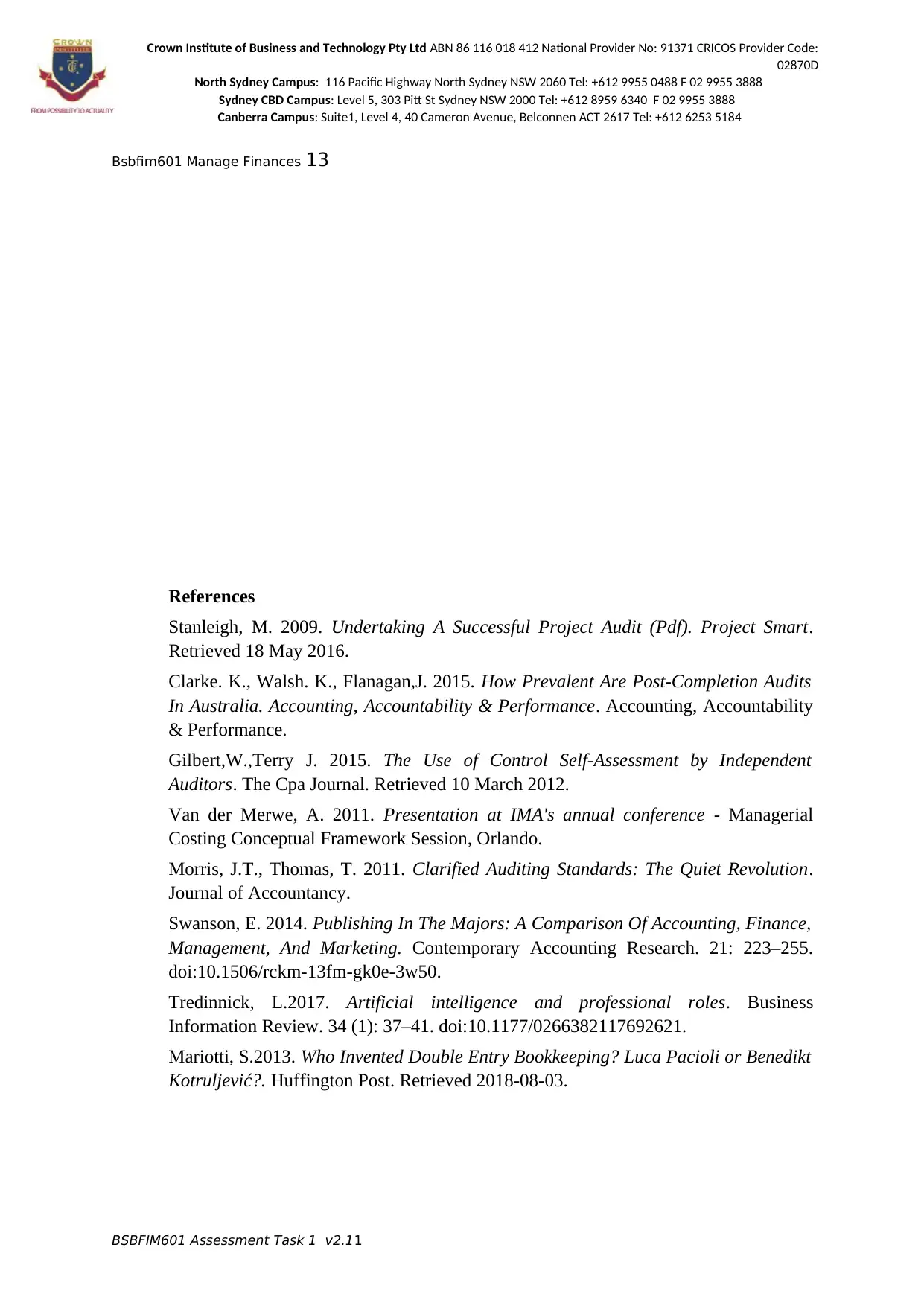
Crown Institute of Business and Technology Pty Ltd ABN 86 116 018 412 National Provider No: 91371 CRICOS Provider Code:
02870D
North Sydney Campus: 116 Pacific Highway North Sydney NSW 2060 Tel: +612 9955 0488 F 02 9955 3888
Sydney CBD Campus: Level 5, 303 Pitt St Sydney NSW 2000 Tel: +612 8959 6340 F 02 9955 3888
Canberra Campus: Suite1, Level 4, 40 Cameron Avenue, Belconnen ACT 2617 Tel: +612 6253 5184
Bsbfim601 Manage Finances 13
References
Stanleigh, M. 2009. Undertaking A Successful Project Audit (Pdf). Project Smart.
Retrieved 18 May 2016.
Clarke. K., Walsh. K., Flanagan,J. 2015. How Prevalent Are Post-Completion Audits
In Australia. Accounting, Accountability & Performance. Accounting, Accountability
& Performance.
Gilbert,W.,Terry J. 2015. The Use of Control Self-Assessment by Independent
Auditors. The Cpa Journal. Retrieved 10 March 2012.
Van der Merwe, A. 2011. Presentation at IMA's annual conference - Managerial
Costing Conceptual Framework Session, Orlando.
Morris, J.T., Thomas, T. 2011. Clarified Auditing Standards: The Quiet Revolution.
Journal of Accountancy.
Swanson, E. 2014. Publishing In The Majors: A Comparison Of Accounting, Finance,
Management, And Marketing. Contemporary Accounting Research. 21: 223–255.
doi:10.1506/rckm-13fm-gk0e-3w50.
Tredinnick, L.2017. Artificial intelligence and professional roles. Business
Information Review. 34 (1): 37–41. doi:10.1177/0266382117692621.
Mariotti, S.2013. Who Invented Double Entry Bookkeeping? Luca Pacioli or Benedikt
Kotruljević?. Huffington Post. Retrieved 2018-08-03.
BSBFIM601 Assessment Task 1 v2.11
02870D
North Sydney Campus: 116 Pacific Highway North Sydney NSW 2060 Tel: +612 9955 0488 F 02 9955 3888
Sydney CBD Campus: Level 5, 303 Pitt St Sydney NSW 2000 Tel: +612 8959 6340 F 02 9955 3888
Canberra Campus: Suite1, Level 4, 40 Cameron Avenue, Belconnen ACT 2617 Tel: +612 6253 5184
Bsbfim601 Manage Finances 13
References
Stanleigh, M. 2009. Undertaking A Successful Project Audit (Pdf). Project Smart.
Retrieved 18 May 2016.
Clarke. K., Walsh. K., Flanagan,J. 2015. How Prevalent Are Post-Completion Audits
In Australia. Accounting, Accountability & Performance. Accounting, Accountability
& Performance.
Gilbert,W.,Terry J. 2015. The Use of Control Self-Assessment by Independent
Auditors. The Cpa Journal. Retrieved 10 March 2012.
Van der Merwe, A. 2011. Presentation at IMA's annual conference - Managerial
Costing Conceptual Framework Session, Orlando.
Morris, J.T., Thomas, T. 2011. Clarified Auditing Standards: The Quiet Revolution.
Journal of Accountancy.
Swanson, E. 2014. Publishing In The Majors: A Comparison Of Accounting, Finance,
Management, And Marketing. Contemporary Accounting Research. 21: 223–255.
doi:10.1506/rckm-13fm-gk0e-3w50.
Tredinnick, L.2017. Artificial intelligence and professional roles. Business
Information Review. 34 (1): 37–41. doi:10.1177/0266382117692621.
Mariotti, S.2013. Who Invented Double Entry Bookkeeping? Luca Pacioli or Benedikt
Kotruljević?. Huffington Post. Retrieved 2018-08-03.
BSBFIM601 Assessment Task 1 v2.11
1 out of 13
Your All-in-One AI-Powered Toolkit for Academic Success.
+13062052269
info@desklib.com
Available 24*7 on WhatsApp / Email
![[object Object]](/_next/static/media/star-bottom.7253800d.svg)
Unlock your academic potential
© 2024 | Zucol Services PVT LTD | All rights reserved.